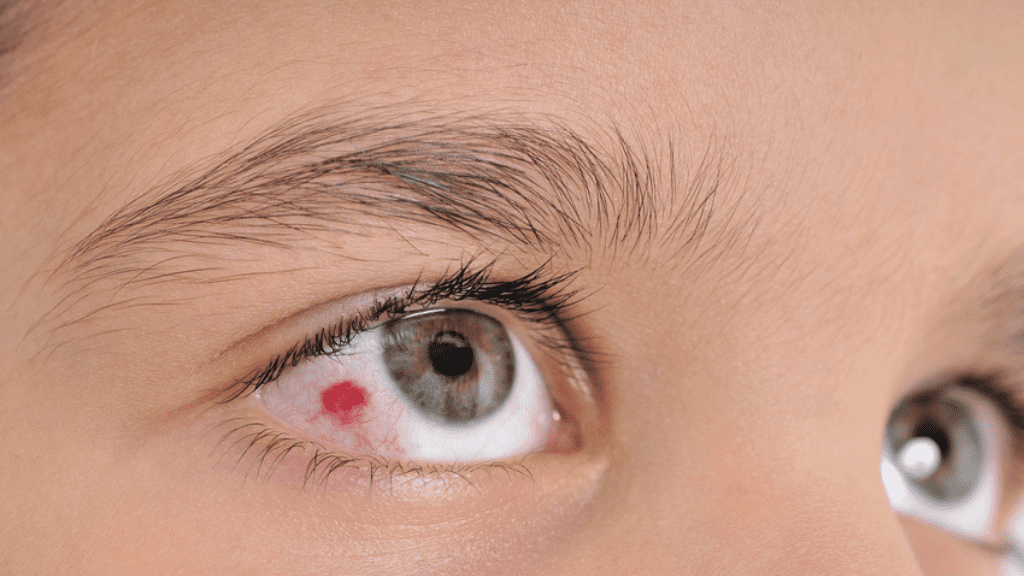
Table of Contents
As your child grows, their eyesight and visual development will undergo many changes. You and your pediatrician should monitor the child’s eye health closely as it can help catch eye problems such as pink eye in toddlers early on. If left untreated, certain types of pink eye can cause infections in eyelids, cornea, and even tear ducts.
To help you catch pink eye or conjunctivitis, we are going to mention everything you need in this article such as what are the symptoms, different types (yes, there are several), the treatment, and when to see a doctor for your toddler’s pink eye, beginning with a better understanding of pink eye. Let’s get started.
What is Pink Eye?
When the transparent membrane (conjunctiva) that lines your eyelid and covers the eyeball’s white part has an infection or inflammation it causes a pink eye. In this type of infection, the small blood vessels in the membrane become inflamed due to bacteria, viruses, allergens, or irritants causing the eyes to appear pink or reddish.
If you think your toddler has pink eye, you should consult your doctor and if the pink eye is contagious, your kids need to stay at home in isolation to decrease the chances of spreading it.
How to Identify Pink Eye?
There are four kinds:
- Bacterial
- Viral
- Allergic
- Irritant
Symptoms of pink eye in toddlers are oftentimes more than just pink or red bumps around baby eyes. Oftentimes there are some unique pink eye symptoms in toddlers such as:
- A feeling of a dust particle or a sand particle in the eye
- Eye rubbing due to severe itching
- A green, yellow, or white liquid that forms a crusty layer encircling the eye while sleeping
- Bulging eyelids
- Watery eyes
- Less tolerance to light
Itchy, watery, and discolored eyes are caused by irritant and allergic infections. In an allergic infection, there are other symptoms such as
- A running nose
- Sneezing
- Appears in both eyes
Bacterial and viral eye infections may infect one or both eyes. In these cases, the infection spreads to the other eye when the child rubs the infected eye with one hand and uses the same, infected hand to rub the other eye.
What Causes Conjunctivitis?
Since there are four types of pink eyes, there are several reasons why these infections occur. Let’s break them down one at a time.
Viral Conjunctivitis
This eye infection is caused by the virus that leads to the flu and several viral infections and hence it is a contagious version of the pink eye. The pink eye in your toddler may be caused by an infection from someone else or by infection via mucus accumulation.
Bacterial Conjunctivitis
Similar to viral conjunctivitis, this type of eye infection is also contagious and is triggered by a bacterium that causes infections in the ear. Your kid can touch some unclean objects or get in contact with someone with an infection and get a bacterial eye infection.
Allergic Conjunctivitis
It is not a contagious kind of eye infection and it happens when the child’s body responds to allergens such as grass, pollen, or dander. Allergic eye infections can occur seasonally and it also depends on the allergens that are present in the surroundings.
Irritant Conjunctivitis
The irritant eye infection is not contagious and is caused by getting exposed to irritants such as chlorine in the water or smoking, turning the eye pink in color.
When to See a Doctor?
Once you observe changes in the eye and the child has the above-mentioned symptoms, it’s critical to consult a doctor. This helps in getting proper treatment on time and reduces the spreading if it is contagious. If the pink eye is not treated properly, your child’s eyes can be infectious for two weeks.
While the check-up is going on, the doctors will ask for other symptoms and it rarely happens when the doctor collects a sample of the infection and sends it to the lab. This only happens when the condition hasn’t improved after the treatment.
Pink Eye Treatment for Toddlers
For treating pink eye in toddlers, the doctor will prescribe different medications. Make sure you apply them externally as advised by the doctor periodically and if some medication is supposed to be ingested, ensure that it is on time as well.
Treatment for Bacterial Conjunctivitis
Bacterial eye infection is treatable by applying antibiotics topically, but you must ensure that the child utilizes the entire medication through and through even if you see improvement in their eyes.
Oftentimes doctors prescribe antibiotic eye drops, but it can be challenging to get the drops in the toddler’s eyes. In this case, you can apply it by dropping it on the sides of the eyes and when the toddler opens their eyes, it will flow normally into them.
Using an antibiotic ointment is easier in comparison with the drops. You can simply smear the ointment on the edge of their eyes and the antibiotic ointment will flow into the eyes naturally as it liquifies.
Treatment of Viral Eye Infection
Even if you consult a doctor for treating viral eye infections in toddlers, they might suggest home remedies as there aren’t any antibiotics or medication for treating viral conjunctivitis. This infection will cease to exist within a few days. Some home remedies are as follows:
- Using a moist cloth to clean the eyes periodically
- Using cold or warm compresses to relax the eyes
Treatment for Allergic Conjunctivitis
Allergic conjunctivitis treatment is different from viral or bacterial infections. Based on your toddler’s symptoms and the seriousness of the infection, your doctor may suggest an antihistamine and other medication. Also, you can use a cold compress to soothe the eyes.
Treatment for Irritant Eye Infection
One of the most commonly used treatments for irritant conjunctivitis by doctors is by cleansing the irritants out of the eye.
How to Prevent Pink Eye in Toddlers?
The best way to prevent pink eye toddlers is to practice good hygiene but we are talking about toddlers here and managing their hygiene is tough.
Kids in their curious nature will touch objects, themselves, and others while exploring the world. Also, it is a chore to prevent a kid from rubbing their contaminated eyes. You should use the below tips to reduce their chances to get viral or bacterial conjunctivitis:
- Helping them wash hands often
- Regularly changing their blankets, bedsheets, and pillowcases
- Using disinfected towels
- Maintaining distance from children with the infection
Even you can contract pink eye if you are not cautious, so you should also use these methods.
How to Treat Pink Eye in Newborns?
Even a newborn can contract an eye infection and it usually happens when the infant is between 1 day to 2 weeks young. Oftentimes, the infection is caused by infection or a blocked tear duct. Other times, when a baby is being born and passing through the birth canal, it can be accidentally exposed to bacteria or viruses.
In the case of a newborn, you should go straight to the doctor if you see an infection or pink eye symptoms. A doctor will examine the baby and might recommend:
- Antibiotic ointments or eye drops
- Warm commissions to reduce the swelling
- Using a saline solution to remove the excess mucus and pus buildup in the eyes
If a newborn has a bacterial infection in the eyes it is usually caused by the bacteria that cause gonorrhea and if left untreated can cause permanent eye damage.
What Not to Do If You Have a Pink Eye?
If you think you can find pink eye remedies online, you’ll come across some wild and inaccurate suggestions. If you follow them, you might end up with a worse infection than you already have. Here are a few things that you should avoid:
- Don’t use anti-redness eye drops as they could make your condition worse as opposed to soothing your eyes.
- Don’t apply any herbs or food to your eyes until a doctor approves their usage to treat pink eye.
Returning to Daycare or School
Your toddler has to spend away from daycare, school, or other children depending on what kind of infection they have:
- Irritant or allergic eye infection is not infectious, so your kid can attend daycare
- After 24 hours of treating bacterial eye infection with an antibiotic, it is not contagious and hence sending your child to school or daycare is possible
- Viral eye infection has to run its course through your kid’s system so you shouldn’t send them to school or daycare, or in public until their eyes are healed, which could be a couple of weeks.
If you are curious about something you read online and want to try it on your kid’s pink eye, you should consult your doctor first. By doing so, you can save your kid from some potential eye damage or discomfort.
Pink Eye in Toddlers Final Words
In adults, the pink eye usually goes away in 1-2 weeks, but with a toddler’s pink eye you should be extra careful and take them to a doctor as soon as possible. Follow the doctor’s instructions and don’t send the kids out until the doctor says so as it can infect others.
Pink Eye in Toddlers FAQs
1. Can toddlers use eye drops?
2. How do you treat pink eye in toddlers?
3. What Exactly is Pink Eye? How Do You Know If Your Toddler Has It?
4. When should I take my toddler to the doctor for pink eye?
Reviewed By:

Nimrat Sidhu - Pediatration
Dr. Nimrat S Sidhu is a practicing pediatrician for about 5 years now and holds an MD pediatrics degree. She was the topper of her batch, has always had a keen interest in her core medical field, and is specially trained for neonatal resuscitation.
She has published multiple research papers on pediatrics and is interested in topics like Neonatal care, skincare, baby growth, vaccination, growth, and development.









